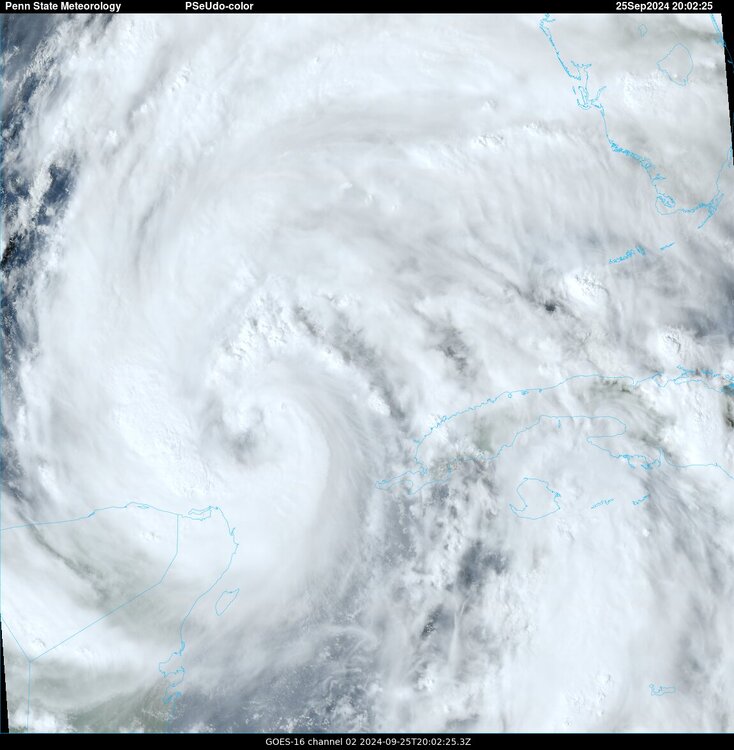
schoeppeya
-
Posts
562 -
Joined
-
Last visited
Content Type
Profiles
Blogs
Forums
American Weather
Media Demo
Store
Gallery
Posts posted by schoeppeya
-
-
HWRF continues to show worse case scenario for TB. Actually re-deepens in a few mb before landfall.
-
10mb drop in between passes?!
-
4 minutes ago, Floydbuster said:
I am not that impressed with Milton tonight. It doesn't seem to be exhausting outflow the way I would like to see for significant overnight intensification. The interaction with the frontal system in the eastern Gulf is also giving it a strange look on satellite. It almost looks like Milton is being undercut or squashed. Anyone else see this?
Looks like a steadily/rapidly intensifying hurricane to me.
-
13 minutes ago, xAllVolsx said:
Don’t the Dam fail after that pic was taken?
Yeah, was implying if it already looked like that before the damn failure its probably going to be completely washed out for a long ways.
-
 1
1
-
-
1 hour ago, WxWatcher007 said:
This this is beneath where the dam just failed, they have have to rebuild a huge stretch of it
-
2 minutes ago, SchaumburgStormer said:
Recon has to be getting the shit kicked out of them on the path they are on through the N eyewall.
That first plane earlier tried and decided thanks but no thanks and went home.
-
Pretty incredible to see the similarities between this storm and Michael. The IR presentation and evolution approaching landfall is even remarkably similar
-
 2
2
-
-
6 minutes ago, WxSynopsisDavid said:
Radar attenuation. Those towers are very large and blocking view of the west and south side of the storm. Reason why the intensification is surprising to you because you didn’t account for such.
We literally do this every single storm storm. Because they always look this way. Regardless of if it’s attenuation or not, nobody should be surprised the backside eyewall looks ragged.
-
 1
1
-
-
Should get an extra boost from frictional convergence here pretty soon
-
Eye is about to clear. Would imagine recon is going to find pressure significantly lower
-
Eyewall complete close off and much more circular on radar, wouldnt be surprised to see another substantial drop in pressure when the new plane arrives
-
 1
1
-
 1
1
-
-
The core looks pretty salty from the tampa radar
-
4 minutes ago, MattPetrulli said:
958.3 extra
Here we go. This is probably about the worst time timing wise for a more rapid intensification to start.
-
4 minutes ago, NeonPeon said:
It's never really hanging on to a stable core structure though. It never has loci of intense convection, just the one, and it hasn't had a stable symmetrical eye either. It keeps looking like it's going to, but can't quite clear itself out.
I dont disagree, but the structure has been continuously improving, just slowly. Until the structure shows an obvious degradation I still think a period of more rapid intensification is on the table.
ETA: Maybe with towers going up on both sides of the eye now we see more sustained eyewall convection
-
4 minutes ago, olafminesaw said:
I mean 105 to 125 in 8-12 hours is certainly not as big a hurdle as y'all make it sound. Not to say it's going to happen. But the bottom line is a major hurricanes is likely at landfall which is not going to have a much different impact than a low end cat 4
Exactly what I have been trying to say, it clears out an eye and we get a 15-20 millibar drop in pressure fairly quickly and its basically right track with where its forecast to end up. There is still more than enough time for that to happen
-
We are at a place now where if we clear out a solid eye the pressure will drop very quickly and suddenly be on track or overperforming models. I think its wayyyy beyond too early to say its going to underperform until something clearly disrupts the continued organizational process.
-
 1
1
-
 1
1
-
-
8 minutes ago, Radtechwxman said:
That dry air definitely made it into the COC. Degraded it more than I anticipated. Curious what hurricane hunters will find intensity wise. Wondering when Helene will really take off.
Pressure down a couple millibars so dont really know that it was degraded per se
-
-
Definitely can see the eye trying to close off on visible
-
3 minutes ago, NeonPeon said:
Can someone clarify something for the uneducated.
The storm seems to have some dry air entrainment, but the general discussion has been that this was not likely to be an issue with this storm. Is what I'm seeing on satellite as dry air just subsidence from a storm that is lopsided, with an asymmetrical core? Are they one in the same?
My guess is we are probably just seeing some structural changes and it may try and clear out an eye before the pressure starts falling again. Even when storms are going through RI we see periods where the pressure drops pause while the storms "consolidates" before the next wave of intensification.
-
Yeah recon shows how large the eye is with a huge area of lighter winds, pretty wild
-
Certainly one of the most impressive satellite presentations I can remember for a tropical storm!
-
 1
1
-
-
towers blowing up over the llc now
-
Definitely some southerly shear still but should be a more favorable vector and starting to see some storms wrap around the northern side of the storm.



Major Hurricane Milton
in Tropical Headquarters
Posted
Considering we are on the cusp of 5 already I think that's almost a lock at this point